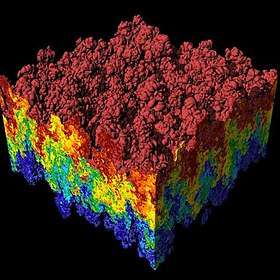Anwar Ali (physicist)
Anwar Ali (b. 1943, NI, HI, PP, MSc), is a Pakistani physicist and a computer programmer who served as the Chairman of the Pakistan Atomic Energy Commission (PAEC) from 2006 till 2009.:431[1] His scientific career is spent at the Pakistan Atomic Energy Commission as a computational physicist and played a key scientific role his nation's secret nuclear deterrent program.[2]
Anwar Ali | |
|---|---|
| Born | 1943 (age 76–77) |
| Citizenship | Pakistan |
| Alma mater | Government College University University of Punjab University of Birmingham |
| Known for | Pakistan's nuclear deterrent program Computational science, automatic controls, and computer programming |
| Awards | |
| Scientific career | |
| Fields | Computational physics |
| Institutions | Pakistan Atomic Energy Commission |
Biography
Early life
Born and hailed from Hoshiarpur in India, Ali was attended the Government College University in Lahore where he graduated with Bachelor of Science (BSc) in physics, and went to attend the master's program in physics at the Punjab University where he graduated with Master of Science (MSc) in physics.:538[3] He attended the University of Birmingham where he graduated with MSc in nuclear physics.:538[3][4]
In 1972, he pursued the doctoral studies in physics at the Birmingham University but left his dissertation studies when he learned of India's nuclear test, 'Smiling Buddha' on 18 May 1974.:538[3][5]
Pakistan Atomic Energy Commission

After his graduation from Punjab University, Ali found employment with the Pakistan Atomic Energy Commission (PAEC) in 1967 as a scientific officer at the Atomic Energy Center in Lahore.[4] He joined the Nuclear Engineering Division alongside with Bashiruddin Mahmood, an engineer, and aided in the investigations on the uranium enrichment under Bashiruddin Mahmood in May 1974.[7] Ali was an original member of the uranium investigation team that was working with Mahmood as a principle investigator under advice from Abdul Qadeer Khan.[7] Ali was posted back to Engineering Division of the PAEC after Abdul Qadeer Khan took over the program after moving it at the Khan Research Laboratories in Kahuta.[7]
| Computational physics |
|---|
 |
|
Mechanics · Electromagnetics · Thermodynamics · Simulation |
|
Particle |
In 1978, Ali joined the Airport Development Works— a separate facility working on electromagnetic separation of uranium isotopes independent from Khan Research Laboratories— functioning under its director, Dr. G.D. Alam, at the Chaklala Air Force Base and assisted Alam in designing of the centrifuge and further in computer programing to control the rotation of the centrifuge.:57–58[8][9] There, Ali learned computer programming from Alam who also taught him about the automatic controls after being posted at the Khan Research Laboratories in 1981.:58–59[8][10] Eventually, Ali lost interest in nuclear physics but found himself working in computer coding and researching on the topics and applications involving the fluid dynamics in the computational physics.[9]
In 1982, Ali was in brief conflict with Abdul Qadeer Khan when he was confided about the latter about selling the centrifuge technology to unknown Arab country, and may have be the one who alerted the Zia administration of Khan's motive.[11]:contents[12][9] Following this incident, Ali was transferred at the Directorate of Industrial Liaison until 1985 when he was posted at the Directorate of Technical Development (DTD) where he found himself working as a computer programmer, and aided in developing computer codes for the launch sequences of the missiles.[2] In 1993, Ali accepted the employment with the National Defence Complex, a rocket engine contractor, and played a key role in designing the satellite-based inertial guidance and control system of the Shaheen-I missile system.[13] In 1996, Ali went to join the DTD, and helped write the computer codes for the nuclear devices— he was part of the computer programming team that design the codes for the nuclear devices, codenamed: Chagai-I.[2]
In 1998, Ali was the Director of the Computation at the Atomic Energy Commission and eye-witnessed the nuclear testing at Chagai Hills, and reportedly quoted: "Pakistan has successfully detonated the device and we have made a series of experiments and they have been very successful and the results were as we were expecting and in this series there were six experiments."[14] In 1999, Ali was honored with Hilal-e-Imtiaz (Trans. Star of Excellence) by the President of Pakistan, and remained associated with his nation's strategic program, namely the Shaheen missile system.[4]
In 2002, Ali was appointed as chief technical officer —local corporate designation: Member (Technical)— at the PAEC, and was rumored to become director of the Khan Research Laboratories (KRL), which was rebuffed by the Government in 2004.[11] Ali, who had been the most senior scientist at the PAEC, was confirmed for the appointment of the chairmanship of the Atomic Energy Commission when the Government of Pakistan announced at the news media on 28 March 2006.[4][15] Upon taking over the chairmanship, Ali announced that the PAEC has also promoted the utilization of nuclear technologies in other areas, such as agricultural production and for medical diagnosis and therapy.[16] Ali, as chairman of the PAEC, provided strong advocacy for expansion of the commercial nuclear plants to the Government of Pakistan.[17]"
On 27 January 2006, Anwar Ali, received an invitation letter to visit CERN– a particle physics facility in Switzerland– where Ali and Robert Aymar negotiated an agreement between PAEC and CERN to provide financial, technical, and scientific support in the field of novel accelerator, collimator, particle detector and information technologies, as well as through the training and education of scientists and engineers.[18] Under this agreement, Pakistan upgraded the Compact Muon Solenoid and the Large Hadron Collider by designing and developing the particle accelerators as its lead contractor at the CERN.[18]
On 5 April 2009, Ali, rumored to be given extension from his three-year chairmanship, was confirmed for his retirement from the PAEC and was succeeded by Dr. Ansar Pervaiz on 7 April 2009.[19]
Controversy in Canada
In 1985, the Canadian government launched an investigation on Ali regarding his visit to the county in July 1980 as reported by the Indian news outlets in 2006.[2] In 1980, Ali, who was serving as the Director of the Directorate of Industrial Liaison (DIL), contracted with the Canadian GE alongside with American firms such as the Westinghouse Electric, RCA Corps, and Motorola, to provide power inverter, capacitors, resistors Krytron, and other electronic machine parts.:170[1][2]
The Canadian prosecutors did not identified Ali as a suspect but filed a criminal complaint on three expatriate individuals at the Canadian court as a Wall Street Journal investigation in 1984, based on court documents and interviews with Canadian officials stated:
"In July 1980, two members of Pakistan Atomic Energy Commission came here in secret with a high-priority shopping list: vital parts of Pakistan’s fledgling effort to become a nuclear power...... According to court records here, the two Pakistani officials/scientists who came to Canada– Anwar Ali and I.A. Bhatty – brought with them a list of parts needed for a key item embargoed by the U.S. and others, a high-frequency inverter. This exotic electrical device is used to spin a gas centrifuge at extremely high speeds to enrich uranium. The parts were bought from manufacturers, including General Electric Co., Westinghouse Electric Corp., RCA Corp., and Motorola, Inc., by two small electrical equipment stores in Montreal, according to the court papers. Then they were repackaged and shipped on to the Pakistan".[2][20]
The investigations fell apart when Canadian authorities were unable to establish the link of proliferation between the suspected individuals and court exonerated the accused individuals from any wrong doings with minor court fees and charges.[2]
Awards and honors
- Hilal-i-Imtiaz (1999)[4]
- Pride of Performance (2003)[4]
- Nishan-i-Imtiaz (2015)[21]
See also
References
- Khan, Feroz (2012). "(§ Secret Nuclear R&D Programs)". Eating Grass: The Making of the Pakistani Bomb (googlebooks) (1st ed.). Stanford, CA, USA: Stanford University Press. p. 400. ISBN 978-0-8047-8480-1. Retrieved 10 August 2020.
- "Pakistan's N-chief smuggled devices from Canada: US report", India News Online, 29 May 2006, archived from the original on 14 August 2007, retrieved 20 March 2010
- South Asia. Europa Publications. 2007. ISBN 978-1-85743-393-7. Retrieved 10 August 2020.
- staff reporter, APP (28 March 2006). "Anwar Ali, Karim Ahmed appointed new Chairmen of PAEC, KRL respectively". Paktribune. Pakistan Tribune. Pakistan Tribune. Retrieved 10 August 2020.
- Abbasi, Ansar (3 May 2009), "Dr. Ansar Takes Over as PAEC Chief", The News international, retrieved 6 March 2010
- Landau, Rubin H.; Paez, Jose; Bordeianu, Cristian C. (2011). A survey of computational physics: introductory computational science. Princeton University Press. ISBN 9780691131375.
- "New Head of Pakistan Atomic Energy Commission (PAEC) ties with allegedly Nuclear proliferation network". WMD Insight. WMD Insight. 28 March 2006. Archived from the original (Webcache) on 6 March 2008. Retrieved 20 March 2010.
- Rehman, Shahid-Ur (1999). "Gas centrifuge controversy". Long Road to Chagai (snippet view (google books)) (1st ed.). Printwise publications: Shahid-ur-Rehman. p. 157. ISBN 9698500006. Retrieved 10 August 2020.
- Dr. G.D. Alam's interview with Daily Assas, M. Ahmad, 16 December 1998.
- Shahidur-Rehman, §PAEC contributions to KRL, pp.144-145, isbn, 9698500006
- staff reporter, Dawn newspaper (9 March 2004). "Anwer Ali tipped as next KRL chief". DAWN.COM. Dawn Newspaper, 2004. Dawn Newspaper. Retrieved 10 August 2020.
- Kirk, Russell (2017). Organizational Cultures and the Management of Nuclear Technology: Political and Military Sociology. Routledge. ISBN 978-1-351-50115-6. Retrieved 10 August 2020.
- "New Pakistan Atomic Energy Commission head takes up Post," Islamabad APP, 5 April 2006; "Former Chairman PAEC Made Secretary Science and Technology," Karachi Dawn (internet version), 7 April 2006; "Anwar Ali Takes over as New Chief of Pakistan’s Atomic Energy Commission," Islamabad The News (internet version), 6 April 2006.
- AP archives, Associate Press (1 June 1998). "Pakistan - Scientists given hero's welcome". Associate Press. Associate Press, 1998. Associate Press. Retrieved 10 August 2020.
- "PAEC and KRL get new bosses – Business Recorder". webcache.googleusercontent.com. Business Recorder. Business Recorder. 28 March 2006. Retrieved 10 August 2020.
- "Anwar Ali takes over as PAEC chief". www.thenews.com.pk. News International, 2006. News International. 1 April 2006. Retrieved 10 August 2020.
- (PAEC), Pakistan Atomic Energy Commission (2007). "PAEC undertaking projects for human resource development in high-tech areas: Chairman". PAEC. Retrieved 20 March 2010.
- Aymar, Robert; Ali, Anwar (2006). "Protocol to the co-operation agreement dated 1st November 1994 between the European Organization for Nuclear Research (CERN) and the Government of the Islamic Republic of Pakistan" (PDF). CERN.
- staff reporter, The Nation (7 April 2009). "Dr Ansar takes over as PAEC Chief". The Nation. The Nation. The Nation. Retrieved 10 August 2020.
- Nizamani, Haider; Leonard S. Spector (4 May 2006). "New Head of Pakistan Atomic Energy Commission Apparently Tied to 1980s Nuclear Smuggling". Center of Nonprofileration Studies (CNS). James Martin Center for Nonproliferation Studies. Archived from the original on 3 October 2013. Retrieved 20 March 2010.
- "Award for excellence: Over 150 people to be conferred civil awards". The Express Tribune. The Express Tribune, 2015. 13 August 2015. Retrieved 11 August 2020.
